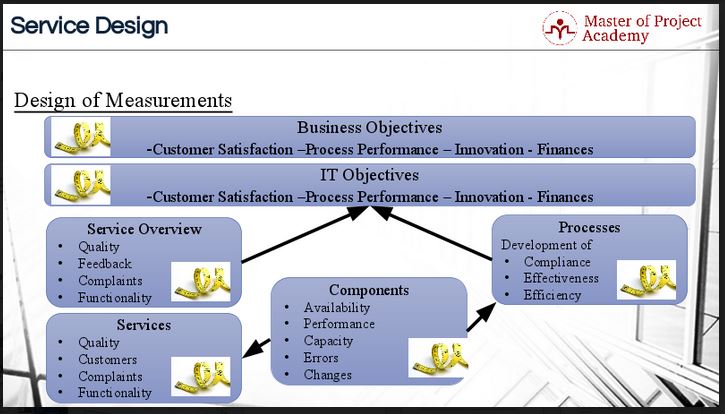Performance measurements are one of the key principles to take into account when designing processes for an IT services according to certified online ITIL courses. These designs take place during the ITIL Service Design stage, which follows on the Service Strategy stage of the ITIL lifecycle.
When designing new ITIL processes or changing existing processes, existing processes should be able to operate, support and manage the new or changed services. Similarly, designing new services or updating existing services of a service provider, these updates or new services should be working in compliance with the other processes of the organization. Performance measurements, as explained in online ITIL training, will determine whether a service complies with the functionalities for which it was intended within the scope of the other processes that interacts with the service.
If the performance measurements show that the new service is not compliant, there will be a conflict between the new services or updates and the existing processes that can affect the service delivery of the organization severely. The conflict will need to be resolved in such a way that the performance measurements show that the new process runs efficiently and effectively within its given environment. New services that run in compliance with existing services will result in cost-effectiveness and efficiency, thereby creating value for the company.
What is their role in detecting incompatibility between services?
If existing processes of the organization should not be able to operate, support or manage the new or changed services, either the design of the service should be revised or the abilities of the existing processes should be expanded to support the new services or changed services. Otherwise, inoperable services and processes won’t produce efficient and effective outputs for the service provider according to data from performance measurements.
Note that this applies to all service management processes, not only the processes of the service design stage. If performance measurements show that any other processes in other stages of the service lifecycle are not consistent with the new or changed services, either the services should be revised or the abilities of the non-compliant processes should be improved to support the new services. This will ensure that new or changed services run smoothly within the organization’s existing services environment.
Design of performance measurements
Every organization has goals and objectives and every service that it creates, operates or retires are supposed to be aligned with the goals and objectives of the organization. IT strategies are developed to reach these business objectives and goals of the organization through the development of new services or changes to existing services. This happens in the ITIL Service Strategy stage of the ITIL service lifecycle. The identified services are consequently designed in service design phase of the service lifecycle. And when implementing strategies, designing new services or updating existing services, performance measurements should be done progressively to check whether the productive outputs are generated and the outcomes will ensure to reach the business objectives and goals of the organization. If the performance measurements show that the targets are not going to be met, the designers need to go back to the drawing board to fix the errors.

Types of performance measurements
These performance measurements are done to check different parameters of objectives:
- Customer satisfaction: customer satisfaction leads to repeated use of the service and revenue to the company
- Process performance: these measures ensures that services run efficiently, thereby creating value for the customer
- Innovations: Innovations put an organization ahead of the curve in the market
- Financial figures: In the end, new services and service upgrades must have a financial benefit
These performance measurements are checked to see if both business and IT objectives are met. Subsequently, to meet the IT objectives; services, processes, and components need to meet its objectives respectively. Performance measures include quality measures in the form of customer feedback, complaints of customers and functionality of the services. These performance measures are in place to check whether the designed services meet the expectations.
Monitoring components
Components are combined together to shape processes and services as seen briefly in the online free ITIL courses. There are several aspects of components which affect whether process and services are running effectively and according to target as determined by performance measurements. These are availability, performance, capacity, errors and, changes in components. All of these aspects are monitored with performance measurements to check whether components meet its objectives. And for the processes, performance measurements include the development of compliance, effectiveness, and efficiency of the process.

Where service components meet business objectives
There is a bottom-up approach from components to business objectives. If the components meet the expectations, the services and processes combined with these components will meet the targets as determined through performance measurements. And consequently, performance measurements will show that IT objectives have been met. This, in turn, will ensure that the business objectives met.
When business objectives are met, financial targets are being fulfilled leading to a profitable organization with enough operational funds available to invest in the continual improvement of services or new services that will draw new consumers. Without performance measurements, IT companies are unable to determine whether their services add value to the company and their customers. This is why developing performance measures while still in the service design stage of the lifecycle is so important. If performance measures are developed at a later stage, the components that may perform poorly could possibly not be changed without significant expenditure.

